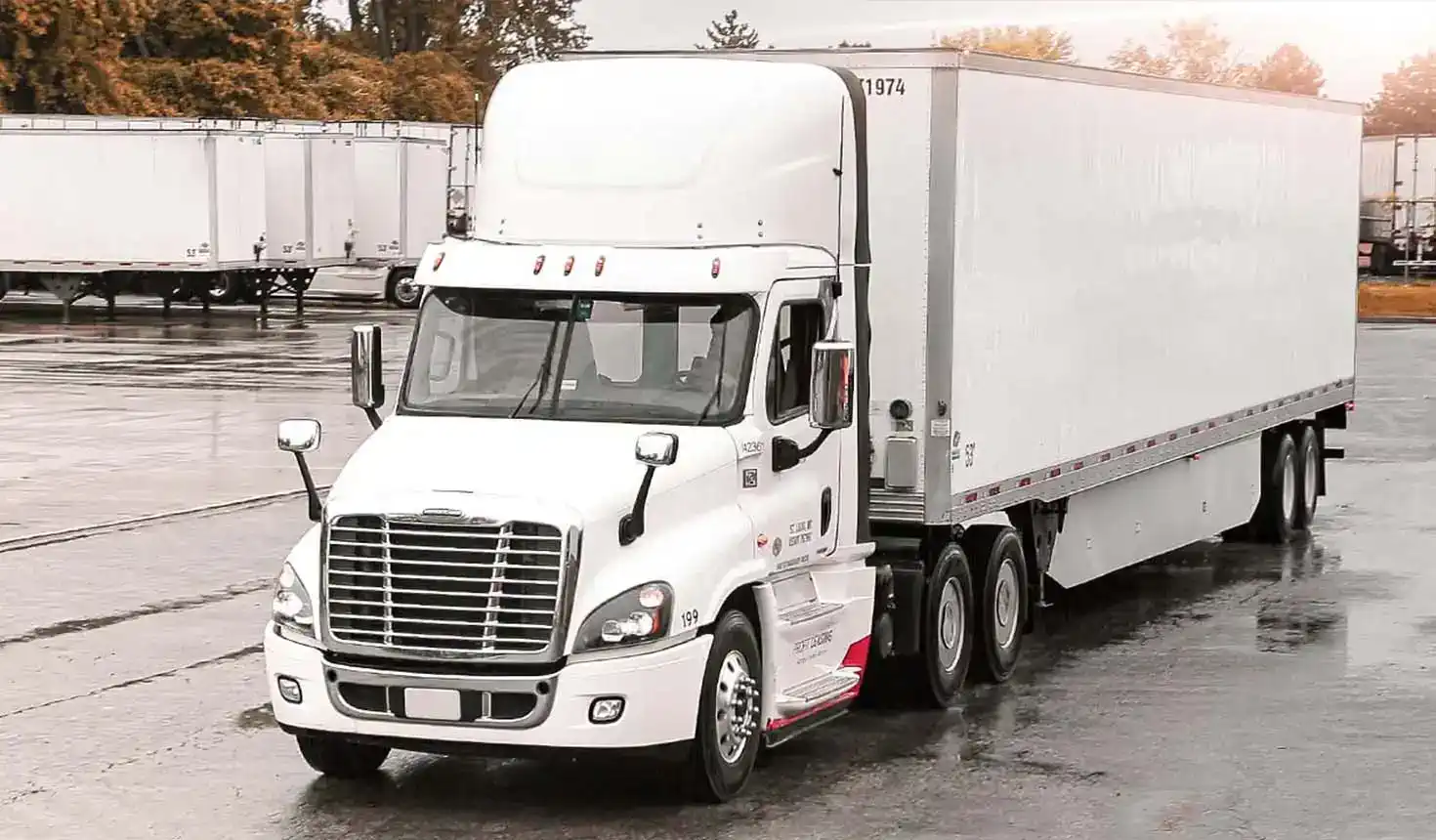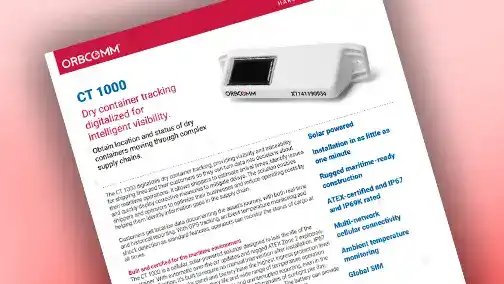
eBooks
The fleet manager’s guide to trailer KPIs

Which trailer KPIs should fleet managers prioritize?
Unlocking untapped potential with trailer telematics
The global trucking industry runs on fuel, but it relies on data. Fleet managers use truck sensor data to drive revenue, boost productivity, minimize costs, increase retention and more. However, data points that are often overlooked—and can provide great value—are those generated by trailers.
Once dismissed as nothing more than “dumb” containers, trailers are proving to be an asset that can do far more than just move cargo. Driven by new capabilities, trailer telematics has grown from providing rough location estimates and other basic data to delivering:
- Live pinpoint asset tracking
- Real-time trailer capacity
- Mileage data
- Detention monitoring
- Tire pressure monitoring
- Temperature, cargo and door status
By investing in trailer telematics and combining these new capabilities with truck data, fleet managers can create key performance indicators—KPIs—that can measure performance and growth from nose to tail within specific areas of interest such as maintenance, cargo security, productivity and asset utilization. Not only will these insights bring fuller visibility and accountability to fleet management, but they’ll also help fleet managers make data-informed business decisions and address top concerns specific to their fleet—from CSA violations and vehicle uptime to driver satisfaction and maintenance costs.

Which trailer KPIs should fleet managers prioritize?
Trailer KPIs—especially for fleets at scale—enable fleet managers to see the full scope of their operations and make data-based decisions. For instance, keeping an inventory of assets can show where waste lies, leading to quick operational changes, like selling extra trailers and tractors or repurposing them to cut costs.
There are many different trailer KPIs that fleet managers can set and monitor; however, targeting all of them would be unwise as too broad of a scope can distract from more focused insights. In this guide, we will explore trailer KPIs that are valuable to the average fleet manager across different areas of business.
Percentage of trailer capacity utilized
This is an important figure to monitor for any fleet manager. If a fleet only utilizes 50% of the total space available, that means thousands of dollars in fuel, maintenance and labor costs go to waste. Calculated by dividing used trailer capacity by total trailer carrying capacity, this KPI can be improved with automated unload notifications from trailer telematics data, enabling fleet managers to reassign unloaded trailers quicker.
Understanding used trailer capacity can inform route planning which could lead to more efficient trips. Plus, it helps fleet managers determine areas where they can cut costs to improve their utilization rate, such as downsizing their trailer fleet.
Combining this trailer KPI with trailer telematics can also provide insight into how many trailers need to be made available in the yard, decreasing the time drivers have to wait to pick up their load.
Fleet managers looking to improve the percentage of trailer capacity utilized could start by investing in cargo camera sensors so they can know when a trailer is empty or full, enhancing load visibility. This will allow fleet managers to add ready-to-use trailers back into the rotation as quickly as possible, send trucks with unused trailer capacity to the nearest load, or reduce wait times for drivers by only sending them to pick up trailers once they are fully loaded.
The average asset utilization rate in the industry is about 50%
Percentage of loaded miles versus deadhead miles
In trucking, waste kills efficiency and breeds costs. One of the main culprits is empty miles—also called “deadhead” or non-revenue miles. When truckers finish a trip, and there is no available load for them to take, they must drive back to the yard or a distant job with an empty trailer in tow, wasting driving hours, fuel and equipment longevity in the process. While the industry average of deadhead miles has stayed around 20% since the 1990s, fleet managers who set the percentage of loaded miles versus deadhead miles as a KPI can improve their efficiency.
Route planning with efficiency in mind can help increase these numbers. For instance, sending one empty trailer across the Midwest to pick up a load may make far less sense than recruiting one nearby, effectively minimizing the deadhead miles. In addition, dispatchers can leverage technology like job workflow software and trailer telematics, to create the most economical routes for drivers. On the logistics side, scheduling loads into the future and planning trips months ahead can ensure drivers are constantly working jobs and earning revenue.
Trailer-tractor ratio
Trailer-tractor ratios can keep fleet managers awake at night if they’re out of balance. Maximizing fleet efficiency involves ensuring trucks can run profitably for 24 hours a day, if necessary, without waiting for available trailers. As a result, fleet managers should strive for a trailer-tractor ratio that optimizes truck uptime. Technology can play a pivotal role in determining optimal trailer fleet size and revealing where any waste lies.
For instance, fleet managers can use trailer telematics to find inactive trailers, which could indicate an unnecessary surplus of trailers. Finding the ideal trailer-tractor ratio is paramount for fleet managers as orders for new trucks and trailers need to be sent to manufacturers as far as 12 months in advance. Renting or leasing trailers can be a useful tool for experimenting with expanding a fleet to improve efficiency, as they can be added or removed from trailer pools without the permanent capital investment.
According to a 2018 survey, 56% of participants had a trailer-tractor ratio above two, with California-based fleets pushing past four. While there is merit to keeping additional trailers and tractors in stock in the event of unplanned repairs and maintenance, fleet managers need to ensure they’re improving profit margins by using asset utilization data to determine if their trailer-tractor ratio is working for them.
Unauthorized trailer usage remains a common problem for fleet managers, with many trailers being used for free storage by customers rather than load transportation. Not only does this limit productivity, but it can also prevent fleet managers from finding their actual trailer-tractor ratio, leading to inaccurate procurement planning. Investing in door sensors or monitoring idle reports can play a vital role in discovering trailers that are being used for storage, allowing carriers to quickly get them back into rotation.
Did you know?
Average trailer detention time
Excessive detention time—anything over the typical two hours of “free time”—is frustrating for drivers and fleet managers alike. Not only does it waste valuable driving time, but it also chews into drivers’ available Hours of Service and sets fleet managers behind schedule on their deliveries. Plus, it negatively impacts retention as idle drivers get annoyed by not being back out on the road and fleet managers need to compensate without earning revenue. By tracking the time that trailers are stuck in detention, fleet managers can precisely determine detention time billing, allowing them to regain some of the revenue they’re expected to lose.
From an operations perspective, knowing how long a trailer will take to be loaded and unloaded—with usage reports by location—can help fleet managers plan future trips, reducing driver downtime and deadhead miles while improving retention.
Another tool to determine load and unload times could involve geofencing set around the depot or warehouse where loads are being picked up and dropped off. Once a truck arrives or departs, a notification will automatically be sent to the back office which, when combined with other instances, could provide a healthy average to monitor and work to improve.
Unscheduled trailer repair costs
Fixing trailers is much easier and cheaper in the shop than on the street. Unscheduled repairs can be a financial and operational burden on fleet managers as costs escalate quickly. Trailers must be towed back to the shop for repair, and in cases where the trailer will be out of commission in the long term, cargo will need to be transferred to another trailer.
Plus, since the repairs are unexpected, technicians may not be available to perform service on the trailer, resulting in even more downtime. From a customer relations perspective, broken trailers often mean missed or late deliveries, which, in some cases, could hinder further business.
Tracking unscheduled repair costs allows fleet managers to monitor the predictiveness of their maintenance process. For instance, cross-referencing unscheduled repairs with trailer tire pressure alerts, brake conditions or fault codes could provide a better early warning system for maintenance scheduling than a repair protocol based on part-based time intervals.
Additionally, if a trailer breaks down, the maintenance team could access this valuable information while the trailer is in transit to the bay, speeding up the repair process by giving technicians ample time to diagnose and triage.
Did you know?
- The average trailer is maintained once every 2.7 months
- Fleet managers are holding onto trailers for 12.7 years on average compared to 6.3 years for tractors
Average mileage per trailer part
This is another valuable metric to monitor as it enables technicians to replace equipment in the shop before it fails on the road, reducing costs, vehicle downtime and headaches in the process. What’s more, understanding the average mileage per part within fleets with a mixture of different trailers and parts can enable better identification for future acquisitions by highlighting which parts are more durable.
Telematics can provide data on trailer parts usage based on actual trailer odometer readings or time elapsed since installation. Knowing the average mileage per trailer part involves marking odometer readings when new parts such as tires, brakes, airline hoses, alternators and other components are installed and replaced.
Total cargo damage claims
Customer relationships are an important part of business for fleet managers. Damaged cargo can quickly sour future opportunities and lead to less revenue. Naturally, the quality of the cargo within each trailer is a great KPI to track, as a decrease in total cargo claims in the long term means loads are being delivered as intended.
There are numerous ways for fleet managers to keep an eye on the interior of their trailers to ensure cargo remains upright and protected from end-to-end. One such method is through cargo camera sensors, which allow fleet managers to manually take a photo at any time remotely or capture images based on triggers, such as when a trailer’s door is opened or when the driver begins or ends a move.
Visually checking the product before and after a journey can act as proof of quality delivery to clarify cargo damage claims. Fleet managers can determine where and when cargo was damaged by noting the trigger timestamp and cross-referencing with location data.
Trailer telematics can also play a role in preventing and resolving cargo theft, which continues to be a major threat for carriers. By tracking route deviations or unauthorized usage, carriers can quickly discover when their trailers are off-course and start working on recovering stolen assets faster.

Accessing trailer KPIs with ORBCOMM
Measuring data and setting KPIs is one thing, but hitting these targets is something else entirely. Luckily, fleet managers have plenty of tools and resources to collect data from their trailers and use it to gather insights.
ORBCOMM’s dry tracking solutions give fleet managers complete control and visibility over their trailers, delivering meaningful data and comprehensive reporting that can be used to establish and meet trailer KPIs. This could include unnecessary dwell time by having full operational transparency of each trailer at any time and place, as well as cutting trailer maintenance costs by deploying telematics devices that are ruggedized and built to last. Plus, with live GPS data backed by cellular and satellite connectivity, fleet managers can limit cargo theft which costs the US economy between $15-$30 billion annually.
With the rise of smart trucks, integration and configuration are crucial to creating a truly connected asset that generates and shares data with the rest of the trailer. That’s why we have built trailer tracking solutions that work in tandem with one another to ensure data is being shared freely, leading to further operational intelligence, fleet productivity and cost savings.







